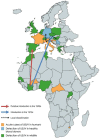Usutu Virus: An Arbovirus on the Rise
- PMID: 31336826
- PMCID: PMC6669749
- DOI: 10.3390/v11070640
Usutu Virus: An Arbovirus on the Rise
Abstract
The Usutu virus (USUV) is a flavivirus that is drawing increasing attention because of its potential for emergence. First isolated in Africa, it was introduced into Europe where it caused significant outbreaks in birds, such as in Austria in 2001. Since then, its geographical distribution has rapidly expanded, with increased circulation, especially in the last few years. Similar to West Nile virus (WNV), the USUV enzootic transmission cycle involves Culex mosquitoes as vectors, and birds as amplifying reservoir hosts, with humans and other mammals likely being dead-end hosts. A similarity in the ecology of these two viruses, which co-circulate in several European countries, highlights USUV's potential to become an important human pathogen. While USUV has had a severe impact on the blackbird population, the number of human cases remains low, with most infections being asymptomatic. However, some rare cases of neurological disease have been described, both in healthy and immuno-compromised patients. Here, we will discuss the transmission dynamics and the current state of USUV circulation in Europe.
Keywords: USUV; Usutu; WNV; emergence; flavivirus.
Conflict of interest statement
The authors declare no conflict of interest. The funders had no role in the design of the study; in the collection, analyses, or interpretation of data; in the writing of the manuscript, or in the decision to publish the results.
Figures


References
-
- Nikolay B., Diallo M., Boye C.S., Sall A.A. Usutu virus in Africa. Vector Borne Zoonotic. Dis. 2011;11:1417–1423. - PubMed
Publication types
MeSH terms
Supplementary concepts
LinkOut - more resources
Full Text Sources

